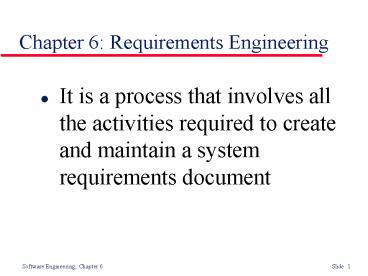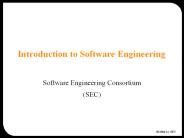Chapter 6: Requirements Engineering - PowerPoint PPT Presentation
Title:
Chapter 6: Requirements Engineering
Description:
It is a process that involves all the activities required to create ... Customer browses through catalog and selects items to buy. Customer goes to check out ... – PowerPoint PPT presentation
Number of Views:35
Avg rating:3.0/5.0
Title: Chapter 6: Requirements Engineering
1
Chapter 6 Requirements Engineering
- It is a process that involves all the activities
required to create and maintain a system
requirements document
2
The requirements engineering process
3
Feasibility studies
- A feasibility study decides whether or not the
proposed system is worth doing - A short focused study that checks
- If the system contributes to organizational
objectives - If the system can be engineered using current
technology and within budget - If the system can be integrated with other
systems that are used
4
Feasibility studypeople involved
- Technical feasibility
- Engineering management
- Engineering tech leads
- Consultants
- Business feasibility
- Product manager
- Marketing
- Sales
- Customer support
- Key customers
5
Elicitation and analysis
- Sometimes called requirements elicitation or
requirements discovery - Involves technical staff working with customers
to find out about the application domain, the
services that the system should provide and the
systems operational constraints - May involve end-users, managers, engineers
involved in maintenance, domain experts, trade
unions, etc. These are called stakeholders
6
Problems of requirements analysis
- Stakeholders dont know what they really want
- Stakeholders express requirements in their own
terms - Different stakeholders may have conflicting
requirements - Organizational and political factors may
influence the system requirements - The requirements change during the analysis
process. New stakeholders may emerge and the
business environment change
7
The requirements analysis process
8
Methods of elicitation and analysis
- Viewpoint-oriented elicitation (VORD)
- Analysis of different stakeholders viewpoints
- Replaced with analysis of actors in use cases
- Ethnography observe user behavior
- Valuable for usability requirements
- Analysis of how people actually work
- Scenarios a subset of Use case analysis
- Use case analysis is discussed here
9
Requirements Elicitation with use cases
- Requirements formulated in terms of use cases and
scenarios - Make easier the communication between
requirements engineers and stakeholders - Help understand the domain
- Requirements collection based on interviews and
discussions with stakeholders - Use cases need to be detailed enough to expose
conflicts - Validate use cases in discussions with
stakeholders
10
Requirements validation
- Concerned with demonstrating that the
requirements define the system that the customer
really needs - Requirements error costs are high so validation
is very important - Fixing a requirements error after delivery may
cost up to 100 times the cost of fixing an
implementation error
11
Requirements checking
- Important qualities
- Understandable to the user does the system
provide the functions which best support the
customers needs? - Verifiable can the requirements be tested?
- Independent of implementation
- Consistent are there any requirements
conflicts? - Complete are all functions required by the
customer included? - Realistic can they be implemented given
available budget, technology and staff? - Validity. Does the system provide the functions
which best support the customers needs? - Precise are the requirements unambiguous?
12
Requirements validation techniques
- Requirements reviews
- Systematic manual analysis of the requirements
- Use case review with customers and requirements
engineering - Prototyping
- Using an executable model of the system to check
requirements. Covered in Chapter 8 - Test-case generation
- Developing tests for requirements to check
testability - Automated consistency analysis
- Checking the consistency of a structured
requirements description (in case it is expressed
in some formal notation)
13
Requirements reviews
- Regular reviews should be held while the
requirements definition is being formulated - Must check the 8 qualities listed before
- Both client and contractor staff should be
involved in reviews - Reviews may be formal (with completed documents)
or informal. Good communications between
developers, customers and users can resolve
problems at an early stage
14
Requirements management
- Requirements management is the process of
managing changing requirements during the
requirements engineering process and system
development - Requirements are inevitably incomplete and
inconsistent - New requirements emerge during the process as
business needs change and a better understanding
of the system is developed - Different stakeholders have different
requirements and these are often contradictory
15
Requirements evolution
16
Requirements management planning
- During the requirements engineering process, you
have to plan - Requirements identification
- How requirements are individually identified
- A change management process
- The process followed when analysing a
requirements change - Traceability policies
- The amount of information about requirements
relationships that is maintained - CASE tool support
- The tool support required to help manage
requirements change
17
Traceability
- Traceability is concerned with the relationships
between requirements, their sources and the
system design - Source traceability
- Links from requirements to stakeholders who
proposed these requirements - Requirements traceability
- Links between dependent requirements
- Design traceability
- Links from the requirements to the design
18
A traceability matrix
M o d u l e s
Req_ID A B C D E F G H
1.1 X
1.2 X
1.3 X
2.1 X
2.2 X
3.1 X
3.2 X
3.3 X
19
Requirements change management
- Should apply to all proposed changes to the
requirements - Principal stages
- Problem analysis. Discuss requirements problem
and propose change - Change analysis and costing. Assess effects of
change on other requirements - Change implementation. Modify requirements
document and other documents to reflect change
20
Scenarios
- Scenarios are descriptions of how a system is
used in practice - A scenario is a sequence of steps describing an
interaction between a user and a system (Chapter
3 of Fowler) - Steps indicate how the system operates
- They are helpful in requirements elicitation as
people can relate to these more readily than
abstract statement of what they require from a
system
21
Use cases
- A use case is a set of scenarios describing a
common user goal - Primary and alternate scenarios
- Alternate scenarios are variations of the primary
(main) scenario - A set of use cases should describe all possible
interactions with the system - Visualized in a UML use case diagram
- Non-functional requirements may not always be
expressed in use cases.
22
Use case buy a product (from Fowler)
- Primary scenario
- Customer browses through catalog and selects
items to buy - Customer goes to check out
- Customer fills in shipping information
- System presents full pricing information,
including shipping - Customer fills in credit card information
- System authorizes purchase
- System confirms sales immediately
- System sends confirming email to customer
- Alternative Authorization failure
- At step 6, system fails to authorize credit
purchase - Allow customer to re-enter credit card
information and retry
23
Use case diagram
- Oval for each use case
- Stick figures for external entities (actors)
- Actors dont need to be human e.g, database,
network, browser - Arrows from actors to use cases
- Not essential
- Types of relationships between use cases
- Include common use case to other use cases
- Generalization use for representing alternate
scenarios - Extend a controlled form of generalization
24
Lending use-case diagram
User
25
Library use-cases
26
Identification of use cases
- Some questions to ask
- Who uses the system?
- Who installs the system?
- Who starts up the system?
- Who maintains the system?
- What other systems interface with this system?
- Who provides information to the system?
- Who extract information from the system?
- Does the system do anything automatically at
present times? - For each use case identify goal, actors, set of
scenarios, and pre- and post-conditions
27
Use case goal and conditions
- Use case goal short statement of what the
primary actor is trying to do - Different goals ? different use cases
- Pre-conditions
- System state before the use case begins
- Post-conditions
- System state after the use case ends































